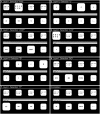Dynamic time window mechanism for time synchronous VEP-based BCIs-Performance evaluation with a dictionary-supported BCI speller employing SSVEP and c-VEP
- PMID: 31194817
- PMCID: PMC6564540
- DOI: 10.1371/journal.pone.0218177
Dynamic time window mechanism for time synchronous VEP-based BCIs-Performance evaluation with a dictionary-supported BCI speller employing SSVEP and c-VEP
Abstract
Brain-Computer Interfaces (BCIs) based on visual evoked potentials (VEPs) allow high communication speeds and accuracies. The fastest speeds can be achieved if targets are identified in a synchronous way (i.e., after a pre-set time period the system will produce a command output). The duration a target needs to be fixated on until the system classifies an output command affects the overall system performance. Hence, extracting a data window dedicated for the classification is of critical importance for VEP-based BCIs. Secondly, unintentional fixation on a target could easily lead to its selection. For the practical usability of BCI applications it is desirable to distinguish between intentional and unintentional fixations. This can be achieved by using threshold-based target identification methods. The study explores personalized dynamic classification time windows for threshold-based time synchronous VEP BCIs. The proposed techniques were tested employing the SSVEP and the c-VEP paradigm. Spelling performance was evaluated using an 8-target dictionary-supported BCI utilizing an n-gram word prediction model. The performance of twelve healthy participants was assessed with the information transfer rate (ITR) and accuracy. All participants completed sentence spelling tasks, reaching average accuracies of 94% and 96.3% for the c-VEP and the SSVEP paradigm, respectively. Average ITRs around 57 bpm were achieved for both paradigms.
Conflict of interest statement
The authors have declared that no competing interests exist.
Figures




Similar articles
-
Asynchronous c-VEP communication tools-efficiency comparison of low-target, multi-target and dictionary-assisted BCI spellers.Sci Rep. 2020 Oct 13;10(1):17064. doi: 10.1038/s41598-020-74143-4. Sci Rep. 2020. PMID: 33051500 Free PMC article.
-
A calibration-free c-VEP based BCI employing narrow-band random sequences.J Neural Eng. 2024 Apr 2;21(2). doi: 10.1088/1741-2552/ad3679. J Neural Eng. 2024. PMID: 38513290
-
A hybrid BCI speller paradigm combining P300 potential and the SSVEP blocking feature.J Neural Eng. 2013 Apr;10(2):026001. doi: 10.1088/1741-2560/10/2/026001. Epub 2013 Jan 31. J Neural Eng. 2013. PMID: 23369924
-
Brain-computer interfaces based on code-modulated visual evoked potentials (c-VEP): a literature review.J Neural Eng. 2021 Nov 26;18(6). doi: 10.1088/1741-2552/ac38cf. J Neural Eng. 2021. PMID: 34763331 Review.
-
EEG-Based Brain-Computer Interfaces.Adv Exp Med Biol. 2019;1101:41-65. doi: 10.1007/978-981-13-2050-7_2. Adv Exp Med Biol. 2019. PMID: 31729671 Review.
Cited by
-
Asynchronous c-VEP communication tools-efficiency comparison of low-target, multi-target and dictionary-assisted BCI spellers.Sci Rep. 2020 Oct 13;10(1):17064. doi: 10.1038/s41598-020-74143-4. Sci Rep. 2020. PMID: 33051500 Free PMC article.
-
cVEP Training Data Validation-Towards Optimal Training Set Composition from Multi-Day Data.Brain Sci. 2022 Feb 8;12(2):234. doi: 10.3390/brainsci12020234. Brain Sci. 2022. PMID: 35203998 Free PMC article.
-
Five Shades of Grey: Exploring Quintary m-Sequences for More User-Friendly c-VEP-Based BCIs.Comput Intell Neurosci. 2020 Mar 10;2020:7985010. doi: 10.1155/2020/7985010. eCollection 2020. Comput Intell Neurosci. 2020. PMID: 32256553 Free PMC article.
-
A Bayesian dynamic stopping method for evoked response brain-computer interfacing.Front Hum Neurosci. 2024 Dec 24;18:1437965. doi: 10.3389/fnhum.2024.1437965. eCollection 2024. Front Hum Neurosci. 2024. PMID: 39776784 Free PMC article.
-
Evaluation of Different Visual Feedback Methods for Brain-Computer Interfaces (BCI) Based on Code-Modulated Visual Evoked Potentials (cVEP).Brain Sci. 2024 Aug 22;14(8):846. doi: 10.3390/brainsci14080846. Brain Sci. 2024. PMID: 39199537 Free PMC article.
References
-
- Wei Q, Gong H, Lu Z. Grouping Modulation with Different Codes for Improving Performance in cVEP-Based Brain–Computer Interfaces. Electronics Letters. 2017;53(4):214–216.
Publication types
MeSH terms
LinkOut - more resources
Full Text Sources

